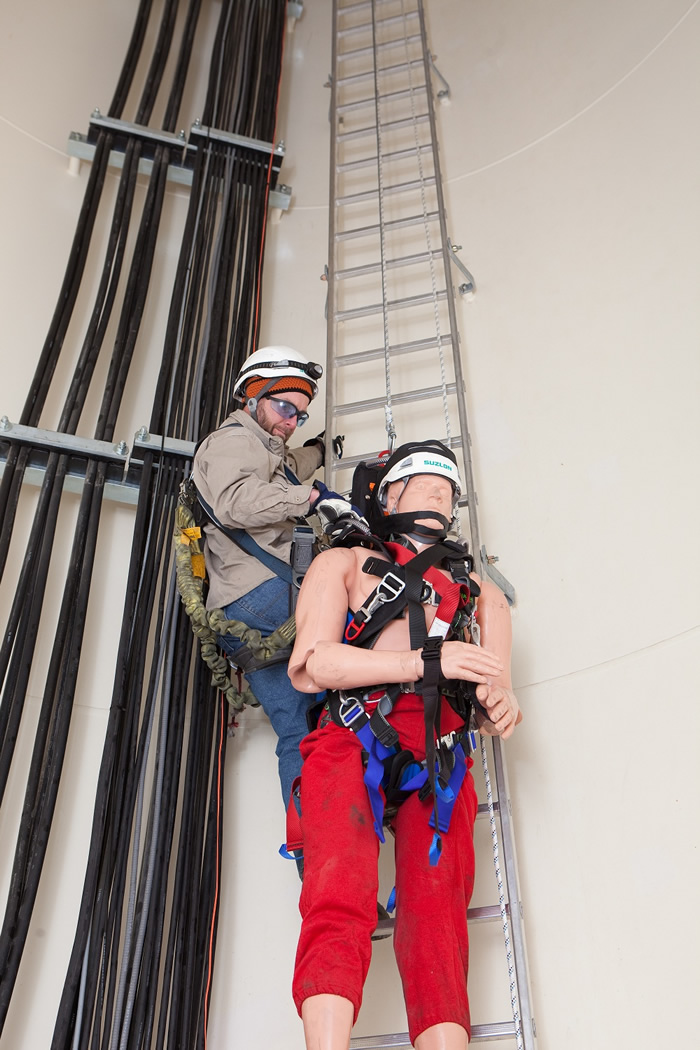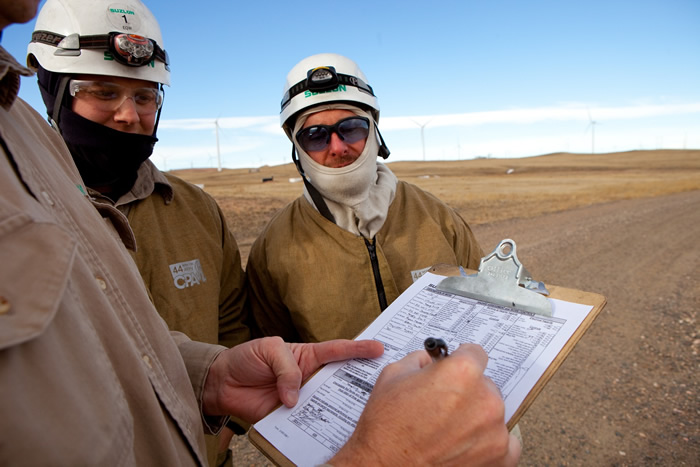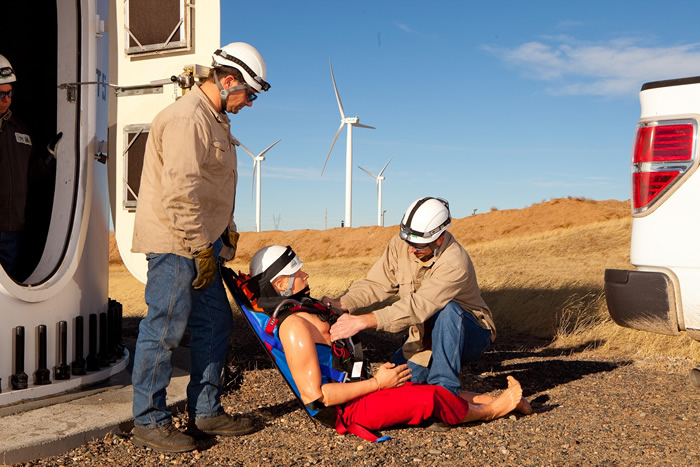It takes more than perfunctory "safety moment" sharing and hard hat stickers to ensure employees and contractors make safety their top priority. In creating a viable safety culture, site leaders first identified the unique strengths of each company and exchanged lessons learned at other power generation facilities.
Bryan Stewart and John Valerius | Suzlon Wind Energy Corporation and Duke Energy Renewables
In late 2011, Duke Energy’s Commercial Businesses presented the President’s Safety Leadership Award to the joint Duke Energy Renewables and Suzlon Wind Energy site team at the 29-megawatt Happy Jack and 42-megawatt Silver Sage wind power projects near Cheyenne, Wyo. This award recognized the exceptional team effort that took the sites’ safety performance to new heights in the previous year.
In the narrative that follows, Bryan Stewart and John Valerius, Suzlon Wind Energy and Duke Energy Renewables’ respective site leads, share the lessons they learned along the way in the hope that they may aid operators at other wind farms throughout the industry.
THE EVOLUTION AND THE GOAL
The Happy Jack Windpower Project, which reached commercial operation in 2008, was Duke Energy Renewables' first wholly-owned commercial wind project. It is located in Laramie County, Wyo., due west of Cheyenne. The adjacent Silver Sage Windpower Project came on line in 2009. The sites are owned and operated by Duke Energy Renewables, which has an onsite team that oversees operations and general site management. Suzlon Wind Energy oversees the maintenance of the sites’ thirty-four 2.1-MW Suzlon turbines under a five-year, full-service agreement.
Productive partnerships require hard work, communication and trust. From the beginning, site leaders from the companies sought to transform Happy Jack and Silver Sage into working laboratories where tried-and-true best practices and innovative ideas could be developed into safety protocols designed to protect both the workers and equipment at the two wind farms. As our collaboration has evolved, the goal remains the same: create and continually enhance a zero-injury and illness culture, one in which the responsibility for hazard identification and mitigation is shared equally among all team members, and everyone feels empowered to prevent accidents.
LESSON 1 - SAFETY FIRST: MORE THAN A HARD HAT STICKER
It takes more than perfunctory “safety moment” sharing and hard hat stickers to ensure employees and contractors make safety their top priority. In creating a viable safety culture, site leaders first identified the unique strengths of each company and exchanged lessons learned at other power generation facilities. Many Duke team members relied on their experiences designing, building and operating fossil-fueled and hydroelectric power plants to ensure the wind farms leveraged best safety practices. This “utility mindset” encouraged rigorous standardization and measurement.
Suzlon Wind Energy’s intense focus on leading by example helped shape the way Happy Jack and Silver Sage site managers model the safety traits and behaviors they expect every employee and contractor to demonstrate each day. Specifically, Suzlon’s “Leading with Safety” training course provides managers with the tools and techniques they need to ensure safety remains the top priority, including recognition and reward mechanisms, employee engagement programs, and documentation templates to track key performance indicators. Leaders are held fully accountable for things that they can control and influence, including conducting safety meetings, inspections and safety audits.
LESSON 2 – COMMUNICATION IS KEY
Open and candid lines of communication have also been critical to our success. Our joint team of 10 full-time staff members at the two wind farms conducts weekly safety briefings and delves deeply into topics such as turbine ladder accident prevention; slip, trip and fall avoidance; and body stress mitigation techniques. Documenting and analyzing a pattern of dropped tools at both sites led to the implementation of a new training program that equips technicians with step-by-step guidance on how to properly handle tools during maintenance exercises. We reinforced the key aspects of the training program through new signage and message reinforcement at team meetings.

LESSON 3 – NO FAULT SAFETY HAZARD IDENTIFICATION
To truly create a sustainable culture of safety, all site workers must feel empowered to identify and communicate potential hazards without fear of retribution for hampering operations. This concept is at the core of our shared safety philosophy. No matter who raises a safety concern, we work together to develop the solution.
For instance, the two companies’ employees jointly hold monthly fire inspections and hazard identification walkthroughs at Happy Jack and Silver Sage. The individuals responsible for conducting the inspections are rotated each month so that fresh eyes can uncover both obvious and subtle risks. Early in the projects’ history, these site employees and contractors identified and addressed a number of seemingly minor but potentially harmful issues, including trip hazards from empty pallets and fire hazards from daisy-chained extension cords and fraying wires.

LESSON 4 – SAFETY EVERY DAY
We developed a Job Safety Analysis (JSA) template for technicians to complete before each tower climb to ensure that safety remains at the forefront of everyday operations. At the beginning of our partnership, Suzlon’s employees shared their company’s wind safety procedures with Duke Energy Renewables employees. In turn, Duke’s employees continue to provide information about safety improvements as they are developed and implemented across the company’s 13 other wind power projects in six states. Although it is impossible to guarantee that accidents will not happen, the JSA provides our technicians with a thought-provoking regimen that reinforces the importance of doing a job safely, not just quickly.
.jpg)
LESSON 5 – LEVERAGING DIVERSE EXPERIENCES & EXPERTISE
A meaningful commitment to safety must involve innovation that is driven by approaching problems in new ways and by leveraging team members’ diverse experiences and skill sets. For example, John once served as a firefighter and emergency medical technician. We incorporated prevention and treatment techniques common to those professions into our site readiness and response plans. Happy Jack and Silver Sage purchased a compact backboard – often used by EMTs at the scene of an accident or crisis – and adapted it for high-angle wind turbine tower rescues. This makes it far easier to secure an injured individual in a confined space and lower them safely to the ground. John’s emergency medical response experience also prompted us to create medical trauma bags customized for a potential wind farm injury. Fortunately, our safety precautions and protocols have prevented us from putting these tools into service in a real emergency. Having them on hand, however, means our workers are trained and better prepared to contend with any crisis that might confront operators of a large-scale wind farm.

Our collective efforts have created an environment of continuous improvement, which is reflected in the safety statistics for Happy Jack and Silver Sage with only one injury in 2011. Since then Suzlon and Duke are proud to report no minor or major injuries to our team.
SPREADING THE WORD
Although we are proud of our joint safety accomplishments, we know we must always be on our guard. Safety hazards are inherent in our line of work. When it comes to identifying and mitigating the risks that pose harm to our employees and our assets, vigilance and creativity are essential.
We believe the lessons we have learned and best practices we have developed over the past four years through our partnership at the Wyoming Happy Jack and Silver Sage wind power projects can help leaders at other wind farms refine their safety protocols and programs. These lessons and practices have become part of the safety culture at other Suzlon and Duke Energy sites. In addition, both companies serve on the American Wind Energy Association’s Environmental Health & Safety Committee, which has proven to be an insightful forum in which to exchange information.
The content & opinions in this article are the author’s and do not necessarily represent the views of AltEnergyMag
Comments (0)
This post does not have any comments. Be the first to leave a comment below.
Featured Product


